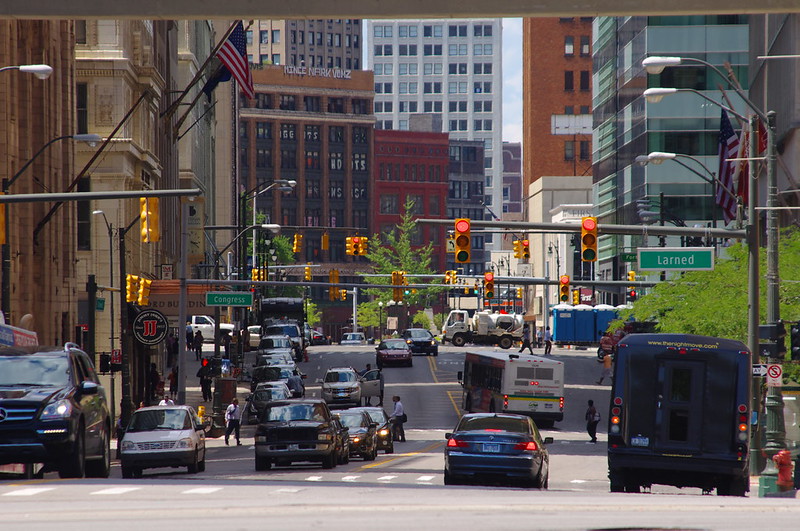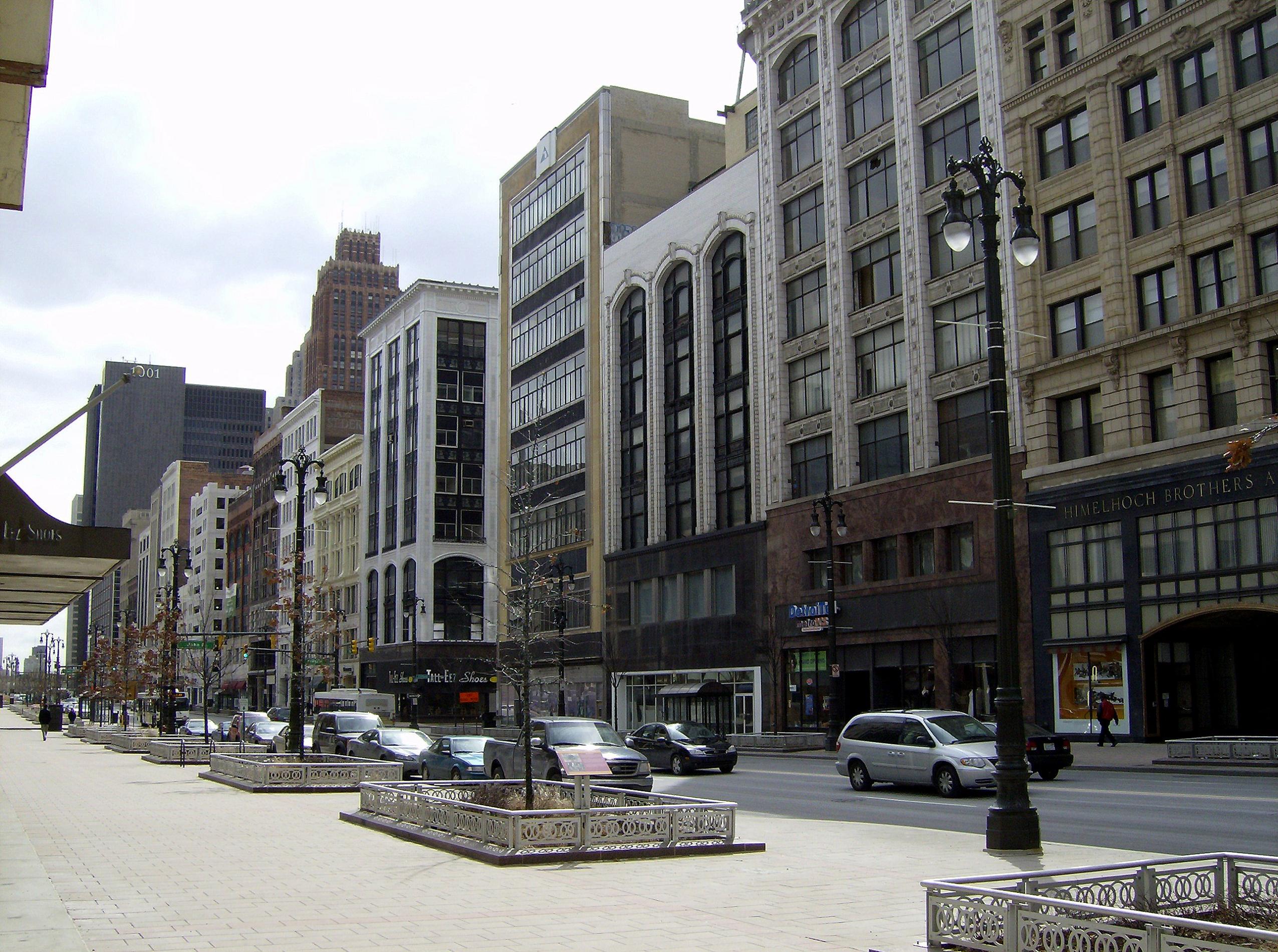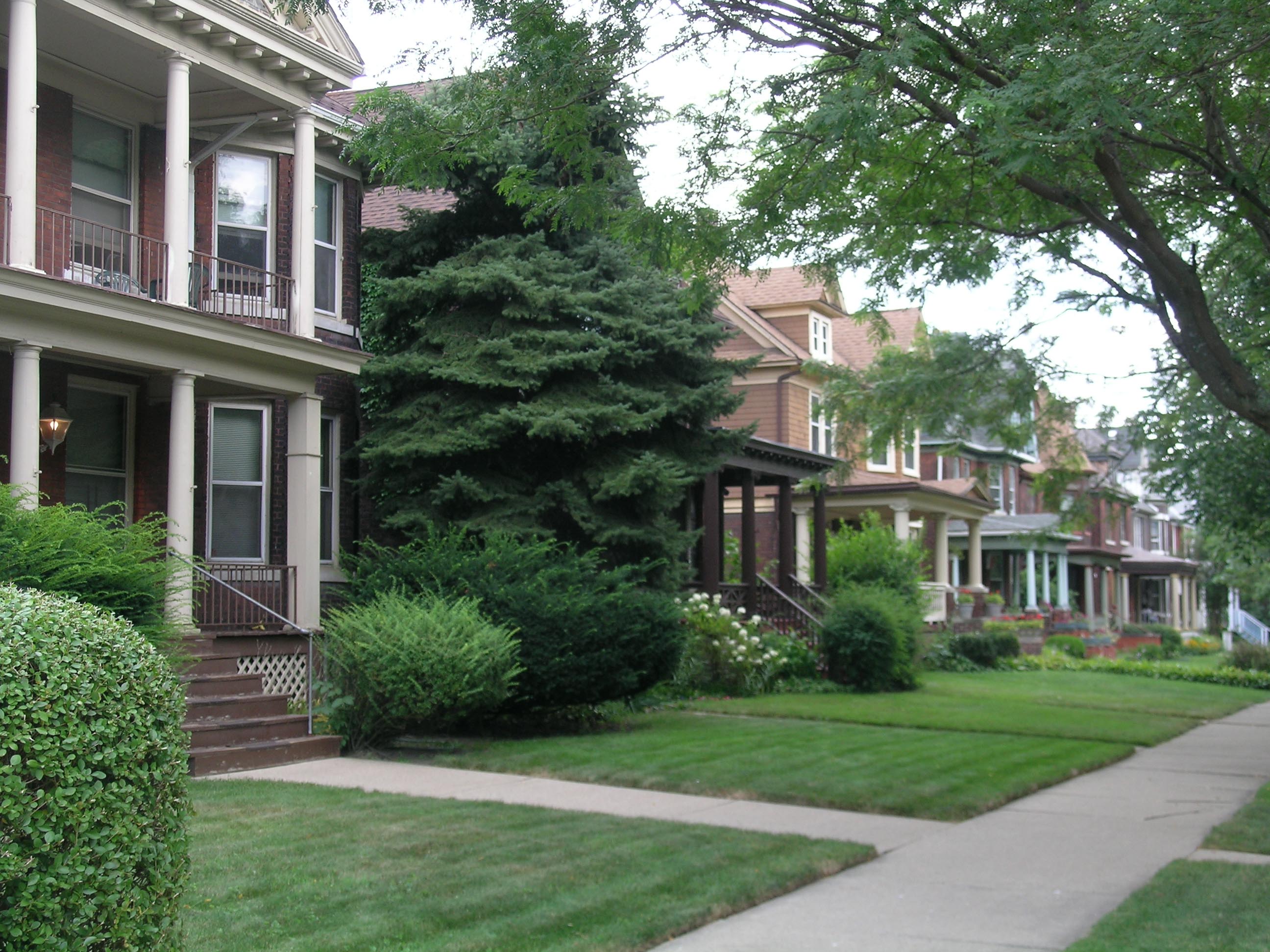Wonder how the city would look without so many buildings torn down.
https://www.flickr.com/photos/photol...d/16209447692//
Results 1 to 25 of 34
Thread: density
-
January-16-15, 02:56 PM #1
 DetroitYES Member
DetroitYES Member
- Join Date
- Mar 2009
- Posts
- 99
 density
density
-
January-16-15, 03:14 PM #2
 DetroitYES Member
DetroitYES Member
- Join Date
- Apr 2009
- Posts
- 7,049

No sense in wondering about it. Those days aren't coming back...
-
January-16-15, 03:52 PM #3
 DetroitYES Member
DetroitYES Member
- Join Date
- Mar 2009
- Posts
- 3,184

What is your point? I can show you a picture of Manhattan.
-
January-16-15, 05:43 PM #4
 DetroitYES Member
DetroitYES Member
- Join Date
- Jul 2011
- Posts
- 1,325

If you mean an area without demolished buildings, Detroit still has those. This is my own photo.

-
January-16-15, 05:48 PM #5
 DetroitYES Member
DetroitYES Member
- Join Date
- Mar 2009
- Posts
- 795

Yeah, might as well focus on what we have [[almost the entire length of Griswold St., for example) and look for places where new construction can plug holes and re-create a true big city atmosphere.
The neighborhoods that were true urban neighborhoods [[there were only so many, perhaps 30% of what we know as our present city limits, though this is still a lot) have indeed been ravaged with the exception of a few blocks here and there. But again, might as well get the creative juices flowing on how to bring about a modern version of the former atmosphere.
-
January-16-15, 06:05 PM #6
 DetroitYES Member
DetroitYES Member
- Join Date
- Apr 2009
- Posts
- 4,513

Downtown Detroit was never as large or as dense as the centers of a lot of US cities. Particularly the ones in the northeast. So what you show is really a false image of what Detroit has ever really been.
But a lot of buildings have certainly been lost through the relentless drive for parking, stalled ill-conceived development projects, and abandonment [[and dumb short-sightedness, like the Lafayette Building). However, there are still a number of places downtown with considerable density. Like this:

What's needed is occupancy, especially at street level, and that seems to be coming along. So I'm not really worried about the density of downtown.
The real problem is outside of downtown, in the neighborhoods. In my mind's eye, the city still looks like this, with rows of occupied housing lining both sites of verdant tree-shaded streets.

But we all know it doesn't look at all like that in most places around the city anymore. That's where the density is really lacking. Indeed, the urban-ness of many of Detroit's neighborhoods has disappeared entirely, and they have ceased to be "city" neighborhoods in any functional sense.Last edited by EastsideAl; January-16-15 at 06:08 PM.
-
January-16-15, 09:51 PM #7
 DetroitYES Member
DetroitYES Member
- Join Date
- Mar 2009
- Posts
- 3,497
-
January-16-15, 10:19 PM #8
 DetroitYES Member
DetroitYES Member
- Join Date
- Mar 2009
- Posts
- 4,520

There is such a thing as too much density also. I used to love downtown Toronto in the 70's & 80's. Now the huge influx of condos has made it virtually impossible to get around both by car and, in many places, on foot. The sunless canyons are freezing cold as well. There is a happy medium out there somewhere. Maybe its Pittsburgh.
-
January-16-15, 10:31 PM #9
 DetroitYES Member
DetroitYES Member
- Join Date
- Jul 2011
- Posts
- 1,325

Toronto is an interesting place because a lot of the historic neighborhoods [[or many historical buildings) directly adjacent to downtown are protected from development which forces areas where development is allowed to have way taller buildings than you normally would have.
Maybe if Detroit actually had preserved many of the core neighborhoods the same thing could have happened? Ya know, minus the urban renewal projects and urban decay.
-
January-16-15, 11:42 PM #10
 DetroitYES Member
DetroitYES Member
- Join Date
- Mar 2009
- Posts
- 1,370
-
January-17-15, 06:10 AM #11
 DetroitYES Member
DetroitYES Member
- Join Date
- Aug 2009
- Posts
- 7

Personally, I just don't get the point of maximum density in a city. I mean, I do. But if I lived in a skyscraper I would much rather look down on tree-lined streets than on the ugly gray roofs of other buildings. Go to the top floors of Royal Oak - Beaumont and tell me I'm not wrong.
-
January-17-15, 08:29 AM #12
 DetroitYES Member
DetroitYES Member
- Join Date
- Mar 2009
- Posts
- 6,547

If you all think Detroit's density is either increasing or decreasing, it decreased by regional and neighbor participation during the past 50 years. Now its increasing by regional and neighbor participation in the new millennium. You all should see what happen to Woodward Ave north of from Mack-M.L.K. Blvd. to the I-94 FWY. I see buildings filling up with people by the thousands. There is no black people putting their businesses in those areas. They are being put out by Dan Gilbert's Gang. So the density of Detroit will rely on two Detroits, a white Detroit along Woodward Ave. from Midtown to Gilberttown and a black Detroit north of I-94 FWY. to 8 Mile Rd.
Last edited by Danny; January-17-15 at 08:31 AM.
-
January-17-15, 10:55 AM #13
 DetroitYES Member
DetroitYES Member
- Join Date
- Apr 2009
- Posts
- 7,049
-
January-17-15, 11:55 AM #14
 DetroitYES Member
DetroitYES Member
- Join Date
- Jan 2011
- Posts
- 210
-
January-17-15, 01:04 PM #15
 DetroitYES Member
DetroitYES Member
- Join Date
- Mar 2011
- Posts
- 5,067

Toronto has had massive development because it has had massive demand. In 50 years, it has gone from smaller and less important than Buffalo to one of the most important cities in North America, probably only slightly less important than Chicago, SF and DC. It's the #2 or #3 immigration hub in North America [[behind only NYC and maybe LA) and replaced Montreal as the primate city of one of the more important countries on earth.
And Toronto is very pro-development. They are not known for historic preservation, at all. The city core has basically been an orgy of [[usually ugly) highrise development from the 1960's onwards.
-
January-17-15, 01:06 PM #16
 DetroitYES Member
DetroitYES Member
- Join Date
- Mar 2011
- Posts
- 5,067
-
January-17-15, 01:53 PM #17
 DetroitYES Member
DetroitYES Member
- Join Date
- Mar 2009
- Posts
- 4,862

Toronto is arguably far more important than Chicago or San Francisco from any non-US-centric viewpoint. It is the financial, cultural and population center of its country, the capital of its largest province, has more foreign embassies/consuls than any NA city besides DC, Ottawa, NYC and Mexico City
in 1961, Buffalo had a population of around 525,000, Toronto had 1.8 million within its current boundaries, 1.9 in the CMA.
Toronto's CMA grew by 800,000 since 61, it's suburbs, however, went from 100K to over 3 million
-
January-17-15, 02:11 PM #18
 DetroitYES Member
DetroitYES Member
- Join Date
- Mar 2011
- Posts
- 5,067

Toronto is somewhat smaller, poorer, and with much less corporate, media and cultural importance than Chicago, DC and SF, so I think it's quite generous to rank it slightly below. Probably Houston or Dallas are the closest American cities to Toronto in terms of population and economic might [[though obviously Toronto is more of a "real city").
Globally it has far less prominence than these cities; I think even Montreal has more prominence [[though that's a relic of Montreal's historically greater importance, probably).
Obviously it's the most important city in its country, but it isn't a remotely comparable country. Is Zurich more important than LA because Zurich is the primate city of Switzerland? I don't think so.
I don't understand your point here. Toronto was smaller than Buffalo back then, city limits are irrelevant, your numbers are obviously wrong, and current population has nothing to do with 50 years ago.
Toronto annexed almost all its postwar suburbs anyways, most of which were empty farmland following WW2. I have no idea where you came up with 1.8 million.
-
January-17-15, 02:48 PM #19
 DetroitYES Member
DetroitYES Member
- Join Date
- Jul 2011
- Posts
- 1,325

You completely missed anything I was saying. It's not whether it's pro or anti-development, it's how the development exists. Toronto has numerous examples of the super dense developments adjacent to low-density developments. Regardless of how much demand there is, it's odd development.
http://goo.gl/maps/twIaZ
http://goo.gl/maps/oBLg6
http://goo.gl/maps/FEhyP
http://goo.gl/maps/r5Dss
My assumption is that these low-rise areas were protected, either directly or indirectly and forcing developments adjacent to them to be extremely tall.
The point I was trying to make was that if Detroit hypothetically had some sort of high growth like that [[either in the future or in an alternate past), would neighborhoods like Corktown or Brush Park exist as preserved historical neighborhoods forcing density into other parts of downtown or other neighborhoods, or would all of those neighborhoods be run over with mid-rises and high-rises?
-
January-17-15, 03:40 PM #20
 DetroitYES Member
DetroitYES Member
- Join Date
- Mar 2009
- Posts
- 559

To add to the Toronto tangent to this thread, here's a link my Canadian brother sent me today:
http://gallery.amazingtwinks.com/17/...tml?id=ville12
The article discusses the difference in Toronto's skyline in just the past 13 years.
-
January-17-15, 05:16 PM #21
 DetroitYES Member
DetroitYES Member
- Join Date
- Mar 2009
- Posts
- 3,184

This. This whole thing is the reason why we repeatedly tell you you have no idea what you're talking about ever.
While it's true Montreal was once larger in population size, today it is not and today Toronto has taken first in "representing" Canada on the global scale. Everyone knows Toronto.
I don't see where you can say Toronto is poorer or smaller. 2.6 million residents in its city alone. That's 7% of the Canadian population. Rosedale, Lytton Park, Bridle Path, Lawrence Park represent some of the wealthiest neighborhoods in all of North America. To say Toronto is poorer is to say Rodeo Drive the poorer version of Fifth Avenue.
And yes Toronto did have a population of 1.8 million in 1961. And when was Buffalo even important in the US? God, that's frickin' laughable to say Buffalo was ever more important in North America than Toronto.
I would Toronto has about the same cultural, media, and/or corporate influence as DC, SF, or Chicago. Hudson's Bay bought Saks and already owns Lord & Taylor. TD Bank has a huge presence in the States. Toronto Film Festival is a major film festival. Just some example of Canadian influences in America.
-
January-17-15, 05:38 PM #22
 DetroitYES Member
DetroitYES Member
- Join Date
- Apr 2009
- Posts
- 4,513

1961 Canadian census metropolitan Toronto: 1.9 million
http://www.demographia.com/db-cancma.htm
1960 U.S. census metropolitan Buffalo: 1.3 million
http://www2.census.gov/prod2/decenni...7no1-40ch1.pdf
-
January-17-15, 06:31 PM #23
 DetroitYES Member
DetroitYES Member
- Join Date
- Jan 2010
- Posts
- 4,867

Density-wise, here is how Detroit metro stacks up in the USA.
Attachment 25565
-
January-18-15, 02:52 AM #24
 DetroitYES Member
DetroitYES Member
- Join Date
- Feb 2010
- Posts
- 4,217

Yes, just as I suspected, Hermod. The density is comparatively high: no problem there.
-
January-18-15, 09:05 AM #25
 DetroitYES Member
DetroitYES Member
- Join Date
- Sep 2013
- Posts
- 262

Very cool picture. I have a good friend[[several actually) who is a Detroit booster and he loves to tell me how if you stand in very specific spots at very specific times Detroit actually feels like a real city. This picture is a perfect example of this. As far as what the density used to be like I'll never forget driving from downtown to the east side and hearing my Dad talk about how those neighborhoods used to be. Bars or shops seemingly on every corner and people going about their daily routine in droves for many unbroken miles. Amazing to imagine it. I wish I had a time machine because Detroit in the 50s would probably be my first stop.
Last edited by TTime; January-18-15 at 09:47 AM.
Welcome to DetroitYES! Kindly Consider Turning Off Your Ad BlockingX
DetroitYES! is a free service that relies on revenue from ad display [regrettably] and donations. We notice that you are using an ad-blocking program that prevents us from earning revenue during your visit.
Ads are REMOVED for Members who donate to DetroitYES! [You must be logged in for ads to disappear]
Ads are REMOVED for Members who donate to DetroitYES! [You must be logged in for ads to disappear]
DONATE HERE »
And have Ads removed.
And have Ads removed.





 Reply With Quote
Reply With Quote



Bookmarks